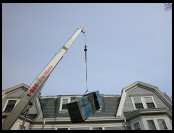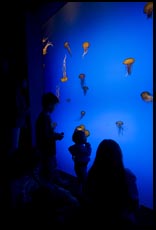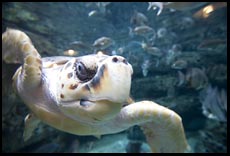

|
Filtrationpart of "A Rich Person's Guide to Aquariums" by Philip Greenspun, updated September 2009 |
 An aquarium filter should
An aquarium filter should
Another way to reduce the noise of water flow is to reduce the volume of water flow. This becomes possible when you have a filter that is able to do a fairly complete job on water in one pass. With such a filter you might only need enough flow to change the tank water twice per hour rather than four or five times per hour.
A final element of noise control comes from the filter design itself.
Where is the pump? How high quality is the pump? Is the pump submersed
in water or out in the open?

My personal favorite technique relies on positioning a spray bar along one horizontal edge of the tank, opposite the filter intake. This results in a surface current running the entire length of the tank. (A spray bar is merely a tube with a bunch of holes in it, all pointing in the same direction, like a flute.)
Note that in a planted aquarium you don't need or want as much agitation. The plants generate some oxygen for the fish. The plants need carbon dioxide (CO2) gas to survive. Heavy agitation tends to let the CO2 escape.
There is only one sterilization technology available today: ultraviolet light. Water is passed in close proximity to a very bright UV bulb and, if the flow is sufficiently slow for the bulb power, this kills most parasites and algae.
Now that we've covered the fundamentals, let's review some specific filtration systems.
Eheim is the only company making canister filters with integrated heaters. Only a handful of Eheim's models provide this feature but those units are adequate for tanks up to 150 gallons or so (and you can always use two on a larger tank). If you decide to get an Eheim, definitely choose the latest "Profi II" models, which include a priming pump on the unit and some other nice advances. For most aquaria, you can safely ignore the Eheim Wet/Dry units. A standard Eheim provides more than ample biological filtration--a test kit will register 0 ppm of ammonia--along with the mechanical filtration that you need and chemical filtration if you stuff in some carbon. The Wet/Dry units provide massive biological filtration capacity but not the critical mechanical filtration that your tank needs.
Servicing an Eheim is very easy and clean. There is a disconnect/shutoff level where the tubes meet the filter so that you can carry the canister into a bathtub, kitchen sink, or utility sink and handle the wet job of changing filter pads, cleaning out debris, etc.
Sadly Eheim seems to ignore the whole issue of UV sterilization. You can pipe the output of an Eheim canister into a UV sterilizer but the resulting setup will involve custom plumbing pieces and won't look very tidy.
Smaller Warts? My personal experience with Eheim has been that the motors begin to buzz a bit after a few months of operation. The buzzing is audible in my bedroom tank though still quieter than the water outflow. Eheims are made in Germany and, by the time they are imported to the US, are much more expensive than other brands of canister filters. Consequently it is difficult to find a shop to sell or support the product. The www.eheim.com Web site is invariably out of date and they don't bother to answer questions submitted via their contact form. Nor do they list their phone number! If you want accurate product information, the German site is a bit better: www.eheim.de. Given the many choices of media for an Eheim canister and the lack of manufacturer support, it is a good thing that the US retailers who stock Eheim tend to be among the higher quality shops.
Here are the problems with the Eclipse/Bio-Wheel hoods:
The Lifegard system is modular and provides the only complete filtration solution by the standards listed at the top: mechanical, biological, chemical, heating, and sterilization. The Lifegard Quiet One pump is extremely quiet, on a par with the Eheim canisters. If its flow rate does not meet your needs, however, you can use just about any other aquarium pump with the Lifegard modules.
Filtration in a Lifegard system usually starts with mechanical. Water has to make it through a Mr. Coffee-style heavy paper filter, cylindrical in shape with pleats. Unlike some competitive designs, each pleat in a Lifegard filter is supposed by a plastic subframe. This keeps the pleats from collapsing as the filter ages. Consequently a Lifegard mechanical filter can go for several months without service where a Marineland pleated filter might need replacement after two weeks. The downside to this subframe is that it makes filter replacement rather more complex. You can do it in one minute but each pleat must be seated over the subframe. The whole process is much easier if you are working with completely dry materials, so budget to keep a spare filter carrier in a drawer. If you have enough space, I recommend getting a double or triple-length Lifegard mechanical filter module. You won't have to service it as frequently as the standard size module.
The Lifegard chemical filter is essentially a big open chamber. You can fill it with carbon, peat (to soften water for Discus), or some sort of substrate for nitrifying bacteria.
For heating, Lifegard makes an empty plastic module into which you slip the heater of your choice. If the heater breaks or is corroded by saltwater, you toss out the $30 heater not the $500 filtration system.
Lifegard makes its own line of UV sterilizers in a variety of sizes and wattages, from 8 watts to 240. For an aquarium up to 250 gallons you probably want at most the 25-watt model.
The Rainbow Lifegard system has been around for many years and I've never heard about an unhappy customer.
The worst thing about the Rainbow Lifegard system is that it is so flexible and comes in so many pieces. The average pet store won't stock it at all or won't have all the pieces that you need for a complete system. Until Rainbow Lifegard comes out with pre-packaged systems, it may be best to buy from a shop that will put together and install your Lifegard system. On the plus side, the www.rainbow-lifegard.com contains comprehensive information and the California-based company provides excellent support to consumers.
My personal experience with Rainbow Lifegard has been on a 90-gallon planted aquarium in an office building. Here's what I found:
In 2002 Rainbow-Lifegard has plans to offer an improved over-the-side plumbing kit, substantially better instructions, some pre-assembled systems, and a better Web site.
My personal bottom line on the Rainbow Lifegard system is that it works great but is noisy enough that I would want to make sure that the pump and UV sterilizer ballast were in an enclosed cabinet or closet.
Another canister filter worth considering is the Rena Filstar Series. These filters run quietly, work well, and are easy to maintain. They probably are not as good as the Eheims...but they are less expensive and many Fish Store carry them.
-- Will Hoerl, March 13, 2003
I've been keeping fishes for 20+ years, including breeding pedigreed goldfishes, bettas, cichlids etc. The easiest and least maintenance filter I have is my present setup: none. ... actually it's java moss (tons of them) in a 100 gallon tank. I change the water once a quarter, and the only maintenance I do is to refill water lost to evaporation and to remove excess java moss. I know the latter is excessive when the fishes can't swim around but are trapped by the moss. The fishes are low maintenance fishes like comets, shubunkins caught from my pond with plecos and some SAEs.
-- Frank Snow, September 27, 2004
It's mentioned that planted aquariums require less surface agitation however not mentioned is the fact that plants USE oxygen when the lights are out. This is well known and I have first hand experience of this, fish happy during lit hours are at the surface gasping for air once the lights are out. You need to ensure that for a healthy balance of fish/plants you either have a extra aerator running when the lights are off or have significantly more surface agitation 24/7. This however has a knock on if you are dosing CO2 (if you are not running a solenoid to turn it off at night I hope you are not keeping any livestock). I found it best to up the CO2 until it hit optimum levels (30-40ppm) and maintain plenty of surface movement day and night. I have to refill my CO2 a bit more often but my local fire safety center fills them for less than ý10 and has supplied me a few old ones they've acquired for peanuts, end result I have 7 canisters which I get refilled all at once and last ages.
-- Chris Ross, March 2, 2016